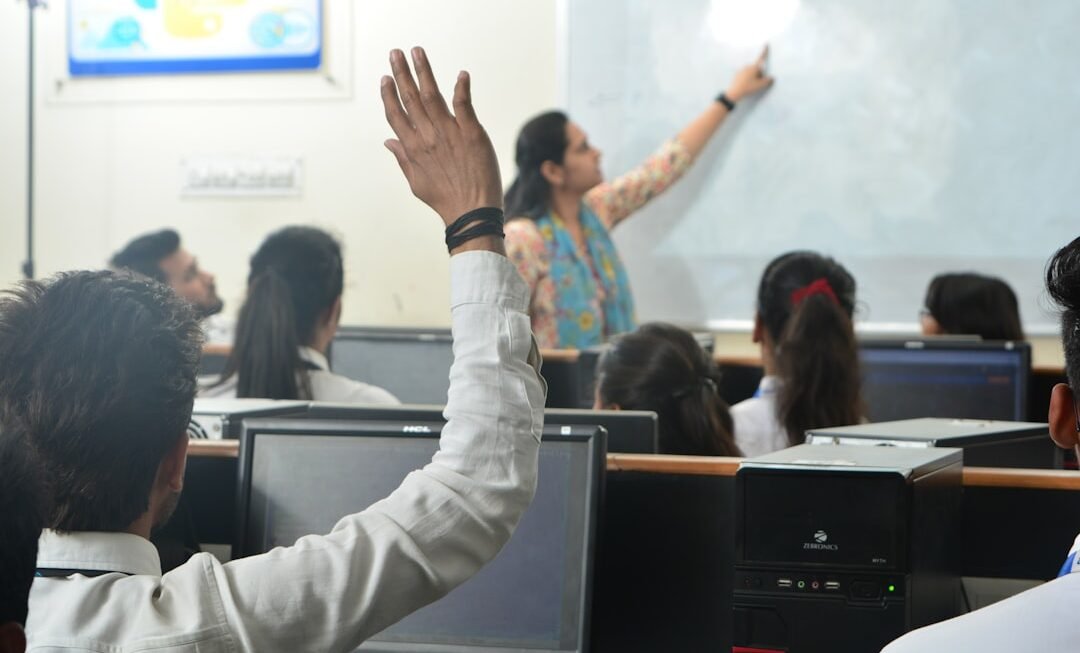The advent of virtual reality (VR) and immersive technologies has revolutionized the educational landscape, particularly in Asia, where rapid technological advancements and a growing emphasis on digital learning are reshaping traditional pedagogical approaches. Virtual reality, characterized by its ability to create simulated environments that users can interact with, offers a unique platform for enhancing educational experiences. In Asian online classrooms, where diverse learning needs and cultural contexts converge, VR provides an innovative solution to engage students in ways that conventional methods cannot.
The integration of immersive technologies into education not only caters to various learning styles but also fosters a more inclusive and interactive learning environment. As educational institutions across Asia increasingly adopt online learning models, the potential of VR and immersive technologies becomes even more pronounced. Countries like China, Japan, and South Korea are at the forefront of this technological shift, leveraging VR to enhance curriculum delivery and student engagement.
The ability to transport students to historical sites, scientific laboratories, or even outer space through VR experiences allows for a deeper understanding of complex subjects. This transformative approach not only enriches the learning experience but also prepares students for a future where digital literacy and technological proficiency are paramount.
Key Takeaways
- Virtual reality and immersive technologies are revolutionizing the way education is delivered in Asian online classrooms.
- Virtual reality enhances the learning experience by providing a more interactive and engaging environment for students.
- Immersive technologies play a crucial role in fostering student engagement and participation in online learning.
- Challenges in implementing virtual reality in Asian online classrooms include cost, technical requirements, and access to necessary equipment.
- Successful case studies demonstrate the positive impact of virtual reality on student learning and engagement in Asian online classrooms.
The Benefits of Virtual Reality in Enhancing Learning Experience
One of the most significant advantages of virtual reality in education is its capacity to create experiential learning opportunities that transcend geographical and temporal limitations. For instance, students can embark on virtual field trips to ancient civilizations or explore the intricacies of human anatomy through 3D simulations. This hands-on approach to learning fosters a deeper connection with the material, as students are not merely passive recipients of information but active participants in their educational journey.
Research has shown that experiential learning can lead to improved retention rates, as students are more likely to remember information when they have engaged with it in a meaningful way. Moreover, VR can cater to diverse learning styles, accommodating visual, auditory, and kinesthetic learners alike. For example, a student who struggles with traditional textbook learning may thrive in a VR environment where they can visualize concepts in three dimensions and manipulate objects within a virtual space.
This adaptability is particularly beneficial in multicultural classrooms found across Asia, where students come from various educational backgrounds and possess different levels of familiarity with technology. By providing tailored learning experiences, VR can help bridge gaps in understanding and promote equity in education.
The Role of Immersive Technologies in Fostering Student Engagement
Immersive technologies extend beyond virtual reality to include augmented reality (AR) and mixed reality (MR), each offering unique ways to engage students in the learning process.
For instance, AR applications can overlay digital information onto the physical world, allowing students to interact with 3D models of historical artifacts or scientific phenomena right in their classrooms.
This blend of the real and virtual worlds not only enhances engagement but also encourages collaborative learning as students work together to explore and solve problems. Furthermore, immersive technologies can facilitate gamification in education, transforming traditional lessons into interactive challenges that motivate students to participate actively. By incorporating game-like elements such as rewards, levels, and competition into the learning process, educators can tap into students’ intrinsic motivation.
In Asian online classrooms, where competition is often a driving force in academic achievement, gamified VR experiences can lead to increased participation and enthusiasm for learning. For example, a language learning platform might use VR scenarios where students must navigate social situations in a foreign language, earning points for successful interactions. This approach not only makes learning enjoyable but also reinforces language skills through practical application.
Overcoming Challenges in Implementing Virtual Reality in Asian Online Classrooms
Despite the numerous benefits of virtual reality in education, several challenges must be addressed to ensure its successful implementation in Asian online classrooms. One significant hurdle is the cost associated with acquiring VR hardware and software. Many educational institutions may struggle to allocate sufficient funds for the necessary technology, particularly in regions where budgets are already stretched thin.
Additionally, the maintenance and updating of VR systems can pose ongoing financial burdens that deter schools from adopting these technologies. Another challenge lies in the need for teacher training and professional development. Educators must be equipped with the skills and knowledge to effectively integrate VR into their teaching practices.
This requires comprehensive training programs that not only cover technical aspects but also pedagogical strategies for utilizing VR to enhance learning outcomes. In many Asian countries, there is a pressing need for educational institutions to invest in teacher training initiatives that focus on immersive technologies. Without proper support and resources, teachers may feel overwhelmed or hesitant to incorporate VR into their classrooms.
Case Studies of Successful Integration of Virtual Reality in Asian Online Classrooms
Several case studies illustrate the successful integration of virtual reality into Asian online classrooms, showcasing innovative approaches that have yielded positive results. In Singapore, for instance, the National University has implemented VR simulations in its medical training programs. Medical students can practice surgical procedures in a risk-free environment, allowing them to hone their skills before working with real patients.
This hands-on experience not only boosts students’ confidence but also enhances their clinical competencies. In South Korea, a high school has adopted VR technology to teach history through immersive experiences. Students can virtually visit historical sites such as Gyeongbokgung Palace or experience significant events like the signing of treaties.
This approach has led to increased student interest in history and improved academic performance as students engage with the material on a deeper level. By providing context and visual representation of historical events, VR has transformed how students perceive and understand their cultural heritage.
The Future of Virtual Reality and Immersive Technologies in Asian Online Education
The future of virtual reality and immersive technologies in Asian online education appears promising as advancements continue to emerge at a rapid pace. With ongoing developments in hardware capabilities and software applications, educators will have access to increasingly sophisticated tools that enhance teaching and learning experiences. For instance, the rise of 5G technology is expected to facilitate seamless streaming of high-quality VR content, enabling real-time interactions between students and educators regardless of their physical locations.
Moreover, as artificial intelligence (AI) becomes more integrated into educational platforms, personalized learning experiences will become more attainable through VR. AI algorithms can analyze student performance data and adapt VR scenarios accordingly, ensuring that each learner receives tailored support based on their individual needs. This convergence of AI and immersive technologies holds great potential for creating dynamic learning environments that respond to students’ progress in real time.
Ethical Considerations and Concerns in Using Virtual Reality in Asian Online Classrooms
While the benefits of virtual reality in education are substantial, ethical considerations must be taken into account when implementing these technologies in Asian online classrooms. One primary concern is data privacy and security. As VR systems often collect user data to enhance personalized experiences, there is a risk that sensitive information could be misused or inadequately protected.
Educational institutions must establish robust data protection policies to safeguard student information while complying with local regulations. Additionally, there is the potential for VR experiences to inadvertently reinforce stereotypes or biases if not carefully designed. For example, if a VR simulation presents cultural narratives from a singular perspective without considering diverse viewpoints, it may perpetuate misconceptions among students.
Educators must be vigilant about curating content that reflects a balanced representation of cultures and histories while promoting critical thinking skills among learners.
Recommendations for Integrating Virtual Reality and Immersive Technologies in Asian Online Classrooms
To effectively integrate virtual reality and immersive technologies into Asian online classrooms, several recommendations can be made for educators and institutions alike. First and foremost, it is essential to conduct thorough needs assessments to identify specific educational goals and challenges within each classroom context. By understanding the unique needs of students and teachers, institutions can tailor their VR initiatives accordingly.
Furthermore, collaboration among educators is crucial for sharing best practices and resources related to VR integration. Establishing professional learning communities where teachers can exchange ideas and experiences will foster a culture of innovation within schools. Additionally, partnerships with technology companies can provide access to cutting-edge tools while ensuring that educators receive adequate training on how to utilize them effectively.
Lastly, ongoing evaluation of VR programs is vital for assessing their impact on student learning outcomes. By collecting feedback from both students and teachers, educational institutions can make informed decisions about refining their approaches to immersive technologies. Continuous improvement will ensure that virtual reality remains a valuable asset in enhancing education across Asia’s diverse online classrooms.












